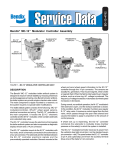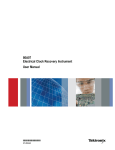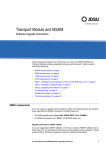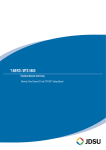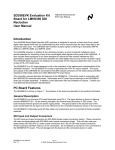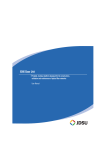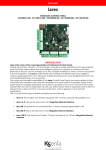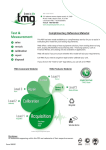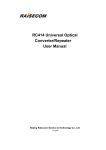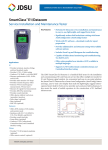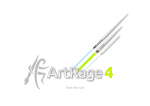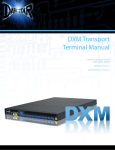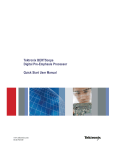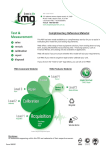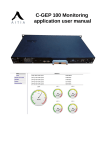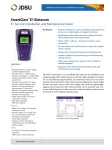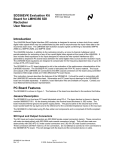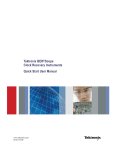Download BERTScope Clock Recovery Instruments
Transcript
ACTERNA TEST & MEASUREMENT SOLUTIONS BERTScope Clock Recovery Instruments Key Features ■ Instrumentation quality clock recovery ■ 150 Mb/s–12.5 Gb/s continuous data rate coverage ■ Accurate variable loop bandwidth from 100 kHz to 12 MHz ■ Auto lock capability with LED display ■ Two hardware configurations, standard data inputs and high sensitivity data inputs ■ Programmable peaking adjustment with first and second order roll off capability ■ Self-measured and displayed PLL frequency response ■ USB control connection to BERTScope or stand alone operation via front panel ■ Single-ended or differential 50 Ω data inputs/ outputs ■ DC coupled data through path ■ Full and divided clock outputs with selectable divide ratios ■ Measurement of clock phase error as a function of frequency and time ■ Data measurement capability ■ Edge Density Measurement — determine the mark density of the signal under test ■ Duty cycle distortion—measure the rising edge timing deviations versus the falling edge timing deviations of the signal under test ■ Ideal for spread spectrum clock (SSC) applications with large jitter excursions The vision of a scope, the confidence of a BERT with clock recovery you can count on. WEBSITE: www.jdsu.com BERTScope Clock Recovery Instruments 2 Compliant Clock Recovery Many communication standards now specify that jitter testing must be carried out using a reference clock that has been derived from the data signal. Typical phase lock loop (PLL) characteristics are specified in terms of the -3 dB bandwidth of the recovery loop, the rate of rolloff of the frequency response, and the degree of response peaking allowable. The BERTScope CR and BERTScope CR HS advanced architectures measure and display the PLL frequency response from 100 kHz to 12MHz; the widest loop bandwidth available for jitter testing on the market today. The first clock recovery instruments to allow full control of parameters including loop bandwidth, peaking/damping and roll off. Design and test engineers can now find and lock onto signals of undefined or unknown data rate. The engineer can recover full rate clocks, including spread spectrum clocks, for signals at data rates from 150Mbps to 12.5 Gb/s. The engineer has full control of key parameters for variable loop bandwidth, peaking/damping and 1st and 2nd order roll offs, optimizing jitter tracking. GOLDEN PLL Many test standards require the use of a Golden PLL (phase lock loop.) Control of the BERTScope CR and CR HS variable loop bandwidth allows for control of the jitter transferred to the recovered clock. When the loop bandwidth setting is narrow, much of the high frequency jitter is removed from the clock signal. The narrowest LBW setting is desirable when an un-jittered clock is required. When the loop bandwidth setting is wide, jitter is transferred to the recovered clock, emulating a clock signal similar to the CDR of the receiver under test. Each standard provides an optimum LBW setting for clock recovery often called the Golden PLL. Recover Clocks for Optical Storage, Enterprise and Telecom Testing The BERTScope CR and BERTScope CR HS have been designed from the ground up to provide users with flexibility and accuracy in compliance measurements. The HS model utilizes high sensitivity data inputs (40 mV single ended, 20 mV differential) with regenerated data outputs. It is ideal for optical test applications, like 4X/8X Fibre Channel and 10G Ethernet standards, where the signal under test must be split off and converted from electrical to optical before fed into the clock recovery data input. The BERTScope CR and CR HS recover a full rate clock up to 12.5 Gb/s, an important requirement for testing XFP and other 10 Gb/s MSA modules. The BERTScope CR HS configuration is also the model of choice in electrical applications where the additional data input sensitivity is critical to the test set-up. Recover Spread Spectrum Clocks for Testing to Electrical Serial Bus Standards Spread Spectrum Clocking (SSC) is an increasingly required feature of serial bus standards. When employed, it can prove difficult to track but its effect must be included in test. These instruments able to track SSC correctly with large jitter excursions up to 5000 ppm, making it unique amongst clock recovery test solutions. The BERTScope CR and CR HS are the first clock recovery instruments to recover clocks from spread spectrum clocked signals used in Serial ATA, SAS, PCI Express and FB DIMM applications. BERTScope Clock Recovery Instruments 3 User Interface The instruments can be used with the BERTScope S Stress Analyzer AND in stand alone operation. Inexperienced users and experts alike will respond to the same ease and accuracy already available in the BERTScope S Signal Integrity Analyzer. Perfect companions to the BERTScope, the clock recovery instruments smoothly integrate with the analyzer, seamlessly sharing a common user interface. A single USB connection and supplied high quality microwave coax cables connect the two units together - that’s all that is required to start measurements. The BERTScope automatically senses the presence of the Clock Recovery instrument, and control is achieved through the Clock Recovery setup screen. It’s that simple. Additional information is also immediately available on the front panel display, showing parameters such as the PLL bandwidth, lock status, bit rate, peaking and roll-off. The system is designed to make sure that you are always aware of the test conditions, always aware of the factors in play that will affect your measurement results. Graphing capability allows the user to plot the loop response and the inverse response curves with 20 dB and 40 dB plot lines and 3 dB point. Cursors are available for marking X-Y axis on each graph. (Future firmware upgrade). For engineers wanting to utilize test equipment already available on their lab bench, the BERTScope CR and CR HS are controllable via the front panel for stand alone operation. In keeping with the BERTScope family’s philosophy of being the easiest to use signal integrity tools available, the clock recovery instruments provide the information you most need immediately available. An instrument front panel display gives critical information on the measurement being made, and settings can also be managed through the knob and 4 buttons located below the display, along with a lock button and LED indicator. This combination ensures that you are never lost, always certain whether the measurement you are making includes the effects of clock recovery. Duty Cycle Distortion—BERTScope CR and BERTScope CR HS are the only clock recovery instruments that can measure the rising edge timing deviations versus the falling edge timing deviations to determine the duty cycle distortion of a signal under test. This output parameter is available via front panel and BERTScope user interface. Clock Out and Sub-rate Clock Out Both clock recovery instruments offer full rate clock out to 12.5 Gb/s and sub rate clock out at all the popular divide ratios (see listing on page 6.) BERTScope Clock Recovery Instruments 4 For easy verification of compliance, the correct characteristics are automatically set when a given standard is selected from a pull-down menu. However, for users wanting to explore the limits of their designs, full control of parameters is also easily available. A good example of this is for systems where restricting the build up of jitter is critical. Clock recovery plays a crucial role in this, and the ability to emulate a clock recovery source with excessive peaking is a great way of understanding the system sensitivity to jitter gain. Each instrument has variable jitter peaking that goes way beyond simple compliance, and allows jitter gain in excess of 10 dB if desired. Remote control of the instrument is easily accessible via USB through BERTScope or via laptop PC. TCP/IP and GP-IB protocol interfaces are supported. • Edge Density The user has the ability to adjust the desired LBW to the edge density of the signal under test. The edge density in monitored and then optimized through loop gain settings. The clock recovery locks on data patterns with 10% to 100% edge densities. • Primary Input Parameters nominal frequency of the data input signal, loop bandwidth, and peaking (up to 6 dB) are configurable on the front panel display. • Lock modes Manual and auto modes are supported. Locking status is displayed as locked—LED green, locking—LED amber, unable to lock—LED red. Lock range, min 10MHz, max 500MHz • Phase Error The clock extraction circuit produces a phase error proportional to the frequency deviation. The phase error deviation is displayed in % peak-peak and %RMS, with 10% min–90% max available range. • Standards 24 industry standards have been pre-programmed into the clock recovery firmware, available via the front panel interface. Custom settings can also be programmed and saved for future use. BERTScope Clock Recovery Instruments 5 Standards Coverage The small graphics and accompanying table show common standards, the data rates they employ, and the loop bandwidths required for compliance measurements. The clock recovery instruments encompass a class-leading majority of the common standards, including those listed in the table and displayed in the graphs. This ensures that your current and future needs will be covered for compliance and beyond. Notes: 1. Ripple at high loop bandwidths in these graphs are a feature of the measurement system rather than the loop. 2. The reference (dotted) lines are placed in identical positions in each graph to aid comparison. BERTScope Clock Recovery Instruments 6 Specifications Standard Ethernet Fibre Channel 10 Gb/s Ethernet transmitter test XAUI 1X 2X 4X 8X 6+ Gb/s Common Data rate Loop band- Peaking clock divide (Gb/s) width (MHz) (dB) ratios 10.312 <4 3.125 1.063 2.12 4.25 8.65 4.976 to 6.375 1.875 0.638 1.2756 2.550 5.100 3.6 (fbaud/1667) 8, ITU 6 (fbaud/1677) other 3.000 10 20 40 80? OIF CEI 11+ Gb/s 9.95 to 11.1 250UI Gen 1 fbaud/1667 15 1.5 0.900 5UI 150.000 fbaud/500 6.000 fbaud/1667 1.800 Slope Spread spectrum clocking -20 dB/ decade No 0.3 max 0.3 max 0.3 max 0.3 max -20 dB/ decade No 0.1 max -20 dB/ decade No 8 MHz foremost tests for ITU applications, BW1667 other. Minimum of 4 MHz for stress testing in one case. 2.09 - 1.25 dB* Type 2 Yes, for SATA. Optional for SAS Gen 1 & 2 categories: ‘i’ (internal, hard drives etc.) and ‘m’ (medium reach) use fbaud/500 and fbaud/10 for Gen 2 and 250UI and 65UI for Genb 1. ‘x’ (extended reach) uses fbaud/1667, Type 2. This is same as SAS. * Implied: spec’d as damping factor of 0.707 min to 1.00 max – conversion taken from Gardner (reference [1]). + Loops bandwidths spec’d with transition density of 1 (100% or 1010101 pattern). Only standard we’re aware of to specify this. Assumption is that loop bandwidth will change proportionally as transition density reduces. 2.09 - 1.25 dB* 2.09 - 1.25 dB* Type 2 Type 2 SATA (see note +) Gen 2 3 30 fbaud/10 SONET/ SDH XFP/XFI OC12/STM-4 OC48/STM-16 OC192/STM-64 Receiver test XFP/XFI Transmitter test SAS 0.622 2.488 9.95 9.95 - 11.2 2.09 - 1.25 dB* 0.250 1.000 4.000 8.000 0.1 max 4.000 0.1 max 24 24 11 to 33 11 to 22 4.8, 6.4, 8.0, 9.6 Forwarded clock 11 to 22 I 2.5 25 1.500 II 5 50 Gen 1 fbaud/1667 1.5 15 5 to 16 8 to 16 0.900 Gen 2 fbaud/1667 3 30 1.800 Type 2 -20 dB/ decade 64 3.2, 4.0 4.8 FB-DIMM1 Fully buffered FB-DIMM2 DIMM PCI express 300.000 -20 dB/ decade Notes No No Yes. – Transmitter test: Full 2nd order SSC swing 0.5 to 2 – Receiver test: 0.06 UI swing 1st order with -20 Yes, optional. dB/decade – Receiver test: 65 ps Up to 1 dB 1st or 2nd pk-pk swing Up to 3 dB order 0.5 to 3 1st order (single pole) * Implied: spec’d as damping factor of 0.707 min to 1.00 max – conversion taken from Gardner (reference [1]). + Loops bandwidths spec’d with transition density of 1 (100% or 1010101 pattern). Only standard we’re aware of to specify this. Assumption is that loop bandwidth will change proportionally as transition density reduces. BERTScope Clock Recovery Instruments 7 Instrument specifications Data input Data interfaces 50 Ω differential or single-ended, DC-coupled. APC 3.5 user-replaceable Planar Crown® adapters. Data rate coverage 150 Mb/s to 12.5 Gb/s Data insertion loss D 1.2 dB (typical) Data input voltage -5 Vmin, +5 Vmax High sensitivity data input voltage -5 Vmin, +5 Vmax, 3 Vpeak-peak Input sensitivity 100 mV single ended (typical) 50 mV differential (typical) High sensitivity configuration 40 mV single ended (typical) 20 mV differential (typical) Data output Phase error out 10% minimum, 90% maximum Edge density 10% minimum, 100% maximum Clock Clock interfaces 50 Ω single-ended, AC Coupled. APC 3.5 user-replaceable Planar Crown® adapter Clock output range 150 MHz to 12.5 GHz (full rate clock output) Loop bandwidth 100 kHz–12 MHz variable Frequency response roll-off -20 dB/ decade and -40 dB/ decade Intrinsic jitter 250fsec RMS Output frequency deviation +500/-5500 ppm (+0.05/-0.55%) (tracking 30 to 33 kHz sawtooth modulated SSC) Clock and sub-rate clock output 250 mV minimum, 1.5 V maximum amplitude Divided clock output Full rate divided by 1, 2, 4, 5, 6, 7, 8, 9, 10, 12, 14, 16, 18, 20, 24, 25, 28, 30, 32, 35, 36, 40, 42, 45, 48, 49, 50, 54, 56, 60, 63, 64, 70, 72, 80, 81, 90, 100, 108, 112, 120, 126, 128, 140, 144, 160, 162, 168, 180, 192, 196, 200, 216, 224, 240, 252, 256, 280, 288, 320, 324, 336, 360, 384, 392, 432, 448, 504, 512, 576, 648 Divided Clock Interface SMA Device info Serial number, revision codes available via front panel display Communication USB cable (supplied). Unit also provides hub capability giving 3 additional USB ports. Ordering Information Ordering number and prices on request. The BERTScope CR and CR HS come standard with USB cable, US power cord, clock and data cables for use with BERTScope S, SMA terminations for data outputs, software on CD ROM, and User’s Manual for stand alone use. BERTScope Clock Recovery Instruments About BERTScopeTM BERTScopeTM is a registered trademark of SyntheSys Research, Inc., a privately held California corporation founded in 1989 with the mission to develop advanced test instruments for identifying and locating the source of errors in high-speed digital bit streams. BERTScope CR pairs with BERTScope to offer the vision of a scope, the confidence of a BERT, and clock recovery you can count on. More information is available at www.bertscope.com. All statements, technical information and recommendations related to the products herein are based upon information believed to be reliable or accurate. However, the accuracy or completeness thereof is not guaranteed, and no responsibility is assumed for any inaccuracies. The user assumes all risks and liability whatsoever in connection with the use of a product or its applications. JDSU reserves the right to change at any time without notice the design, specifications, function, fit or form of its products described herein, including withdrawal at any time of a product offered for sale herein. JDSU makes no representations that the products herein are free from any intellectual property claims of others. Please contact JDSU for more information. JDSU and the JDSU logo are trademarks of JDS Uniphase Corporation. Other trademarks are the property of their respective holders. © 2006 JDS Uniphase Corporation. All rights reserved. 30137432 500 0206 BERTSCOPE.DS.CPO.TM.AE Test & Measurement Regional Sales NORTH AMERICA LATIN AMERICA ASIA PACIFIC TEL: 1 866 228 3762 FAX: +1 301 353 9216 TEL:+55 11 5503 3800 FAX:+55 11 5505 1598 TEL:+852 2892 0990 FAX:+852 2892 0770 EMEA TEL:+49 7121 86 2222 FAX:+49 7121 86 1222 WEBSITE: www.jdsu.com








